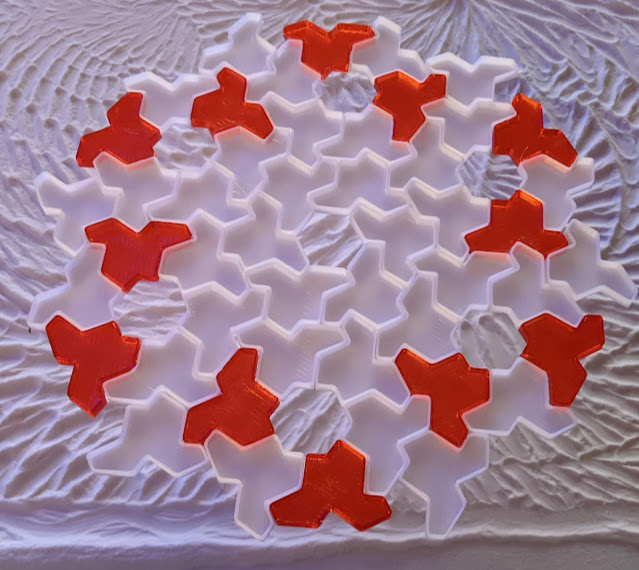What?
Some folks recently came up with a single shape tile (a monotile, or einstein tile) that can tile a surface without the possibility of generating a repeating pattern. There's a simple explanation here:
I first saw mention of it on Hack-a-day (I think, but I can't seem to find it there now), followed the included links and immediately drew a copy in Fusion360 so I could print a bunch of the tiles and play with. A couple days later the NY Times ran an article about it and then Stephen Colbert was joking about it on the Late Show (another one I can't find a link for - don't get old!).
The basic shape, called a "hat" (I think it looks more like a V-neck tee shirt) by the inventor is derived from 3 hexagons, which is how I created the shape in Fusion360.
Here's one of the images that I used to create the Fusion360 model:
Notice that the dark blue tile is a mirror image of the other, lighter tiles that are all the same shape.
I drew a single tile in Fusion360, used one of the diagrams to lay out a bunch of the tiles, then pulled back the perimeter by 0.3 mm. Since each tile was a copy of the original, modifying the original pulled back all the perimeters by 0.3 mm. Then I printed them.
The dark blue tiles in the image above are mirror image of the other tiles that are all the same shape, so I printed a set of those by using the mirror function in Prusa Slicer.
 |
| The tile layout I used in Prusa Slicer- these are the mirror image tiles (dark blue ones from the drawing). |
I printed the tiles on UMMD in red, white, and blue (mirror) PETG so I could play with them a little. UMMD has a 1 mm nozzle and printed in 0.5 mm layers. The base of each tile is just 1 mm thick and the walls are 1 mm thick, so it takes very little filament to print. They print quickly, so you can produce hundreds of them in a couple hours.
 |
| A single tile- the walls are 1 mm thick and 5 mm tall, the base is 1 mm thick (2 print layers). These print fast and use little filament- about 1.3 g per tile. |
The paper that describes these tiles and the mathematical proof of aperiodicity is here.




No comments:
Post a Comment
Leave comments or a questions here and I'll try to post a response as soon as I can.